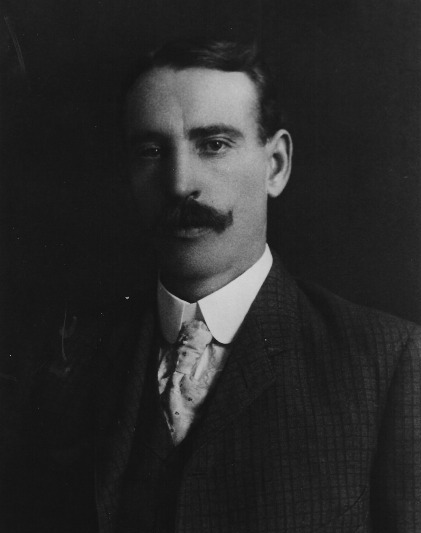
|
Subject: Orville Knighton Reed, known to all in Nye County, Nevada as O.K. Reed. Knighton was his mother's maiden name. Reed came to the Tonopah area in 1900.
|
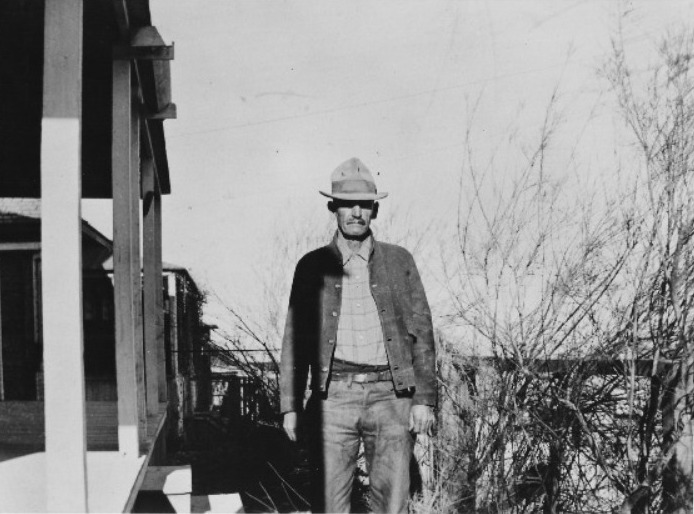
|
Subject: O.K. Reed at his home in Hawes Canyon, Kawich Mountains, Nye County, Nevada, about 1930.
|
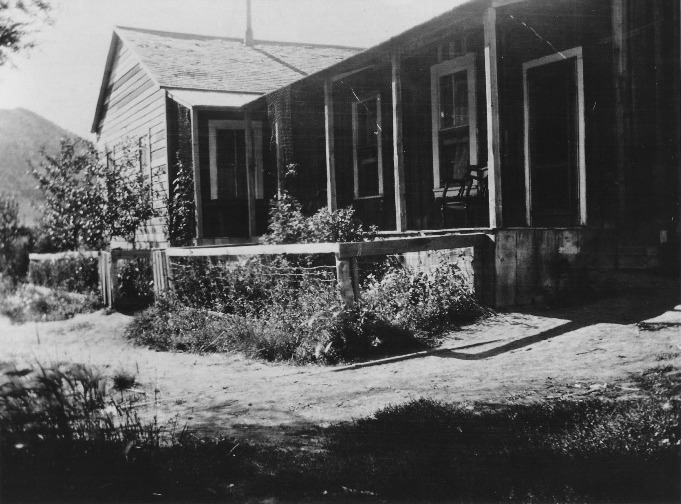
|
Subject: The home of O.K. Reed and his family at Hawes Canyon, Kawich Mountains, Nye County, Nevada. Reed had the home built, it was constructed
by Vic Goodman in about 1908. This photo was probably taken around 1930. The house burned down about 1960.
|
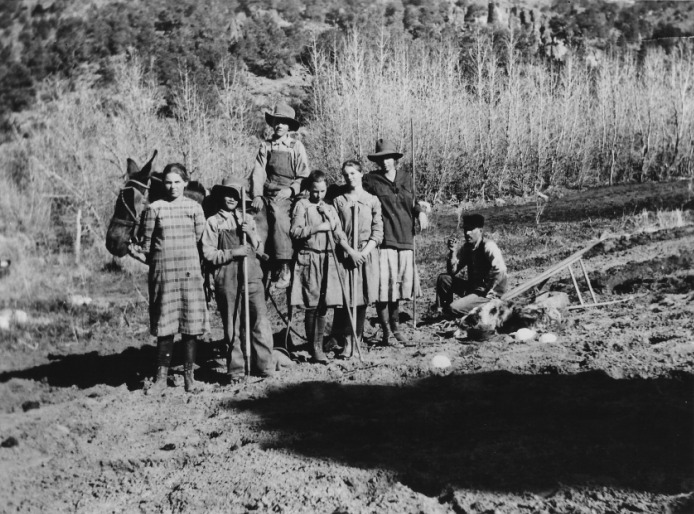
|
Subject: O.K. Reed's ranch at Hawes Canyon, Kawich Mountains, Nye County, Nevada, about 1920. Left to right, Helen Reed, Jack May, Frank May
(sitting on the mule), Lucille Reed, Catherine May, Florence Reed, and O.K. Reed. Catherine May died not long after this
picture was taken.
|
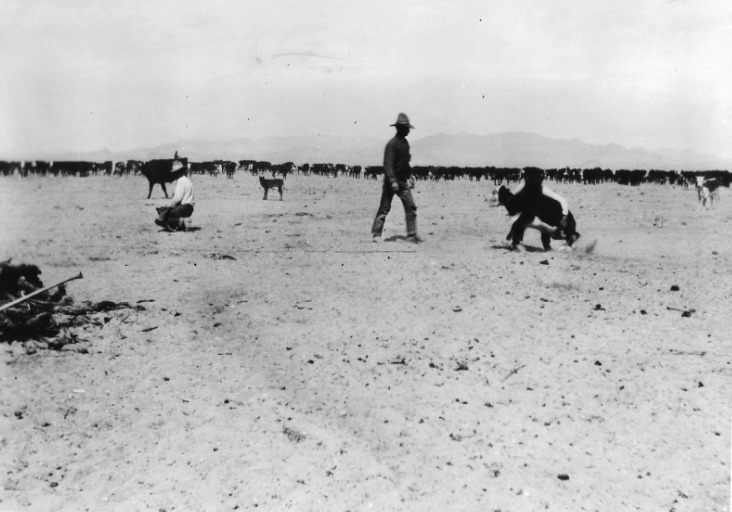
|
Subject: Working cattle on the United Cattle and Packing Company ranch, probably 1920's. The Hip-O, a circle right over the hip bone, was the company's brand.
|
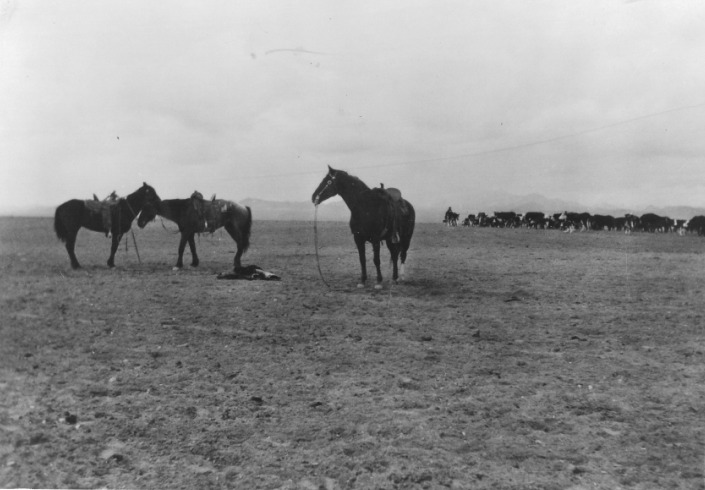
|
Subject: On the range at the United Cattle and Packing Company, early 1920's. The horses are ground tied and will not move; they will stay where they are all day.
|
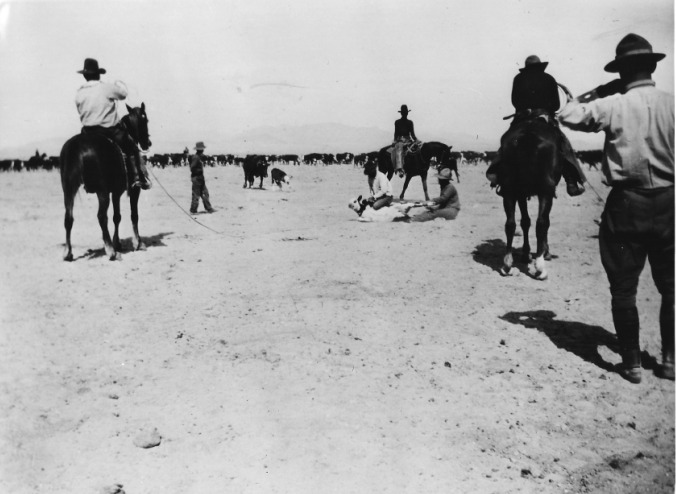
|
Subject: Working cattle at the United Cattle and Packing Company, early 1920's. One cowboy pulls the calf's feet up on the
hocks while another cowboy grasps the head, pinning down the calf. O.K. Reed is standing, second from the left. A calf is
being brought in by the rider on the horse at center rear; the calf's mother follows close behind.
|
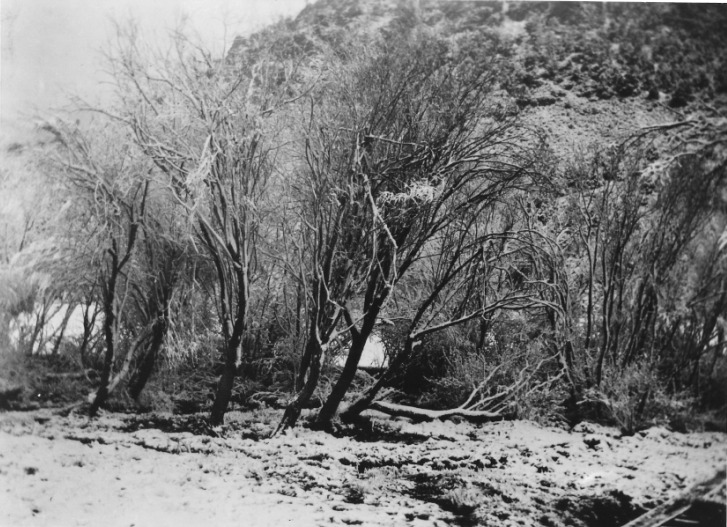
|
Subject: O.K. Reed's ranch at Hawes Canyon, Kawich Mountains, Nye County, Nevada, during a snowstorm in 1927 or 1928. The black willows are believed to have been brought from Elko County by Reed.
|

|
Subject: Willows during a heavy snowstorm in 1927 - 1928 at O.K. Reed's ranch in Hawes Canyon, Kawich Mountains, Nye County, Nevada.
|

|
Subject: The General Store at Nyala, Railroad Valley, Nye County, Nevada, around 1920. The automobile is a 1914 or 1915 model
Ford owned by O.K. Reed. Emery Garrett owned the store. Gasoline then sold for $1.00 per gallon, which was not considered
high-priced even though gas sold for 30 cents a gallon in nearby Tonopah.
|

|
Subject: - Warm Springs, located 50 miles east of Tonopah on U.S. Highway 6, probably early 1920s.
|
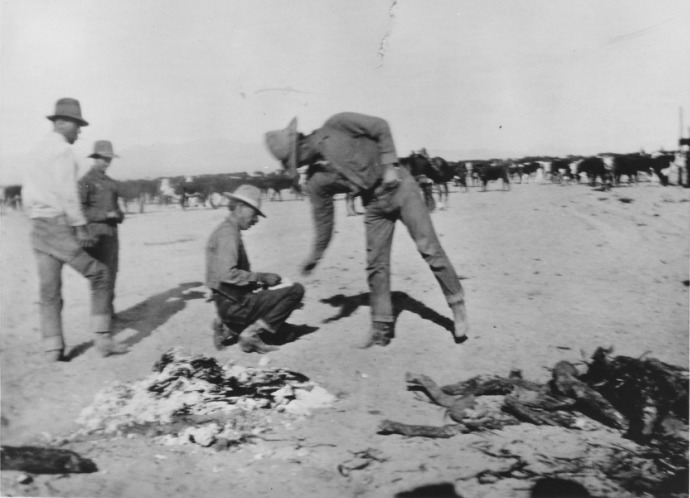
|
Subject: - Working on the range with the United Cattle and Packing Company, early 1920's. When the cattle were branded, a
small piece of ear was removed from each cow. the pieces of ear went into the cowboys' pockets and the ear pieces were later
tallied. Here O.K. Reed (kneeling) is tallying ear pieces. Cuny Kerns, an Indian, is on the far left, next to Frank May.
|
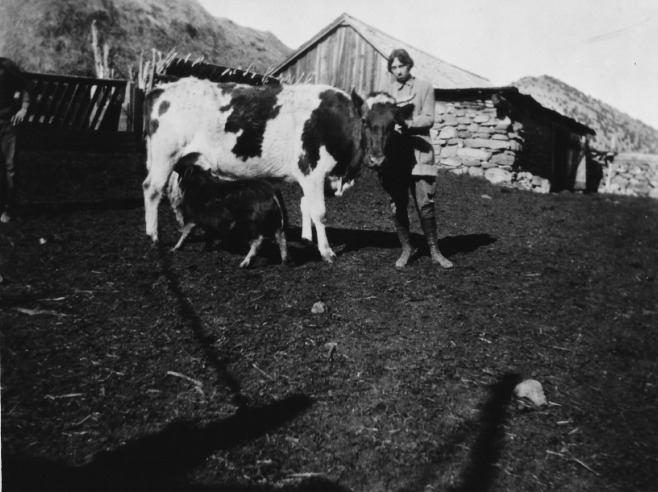
|
Subject: - O.K. Reed's ranch at Hawes Canyon, Kawich Mountains, Nye County, Nevada, early 1920s. People at the ranch noticed
that this cow wasn't giving much milk; upon investigating they found that a pig was stealing it. Here the pig can be seen in
action. Florence Reed, standing, witnesses the crime.
|

|
Subject: - Florence Reed by a then-abundant creek at Hawes Canyon, Kawich Mountains, Nye County, Nevada, early 1920s. Ed Slavin claims that
water was more plentiful in the Kawich Mountains then than it is now.
|
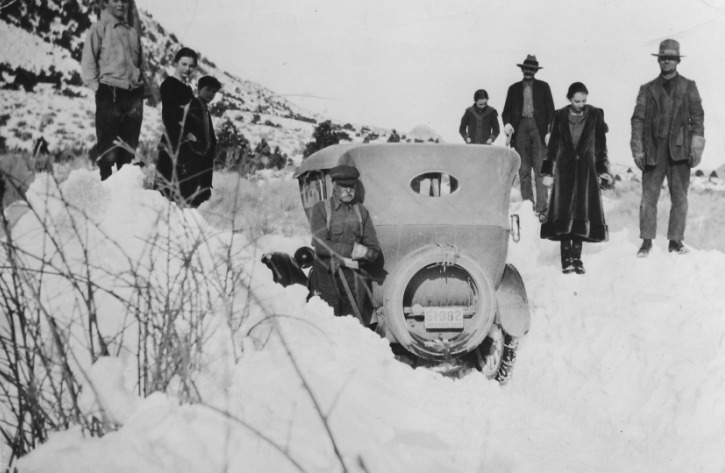
|
Subject: - Snow on O.K. Reed's ranch, Hawes Canyon, Kawich Mountains, Nye County, Nevada, 1921. Left to right, Frank May,
Catherine May, Jack May, Dick Alexander (holding the shovel, sporting a white mustache), unidentified child, Ed Reed and
Florence Reed.
|
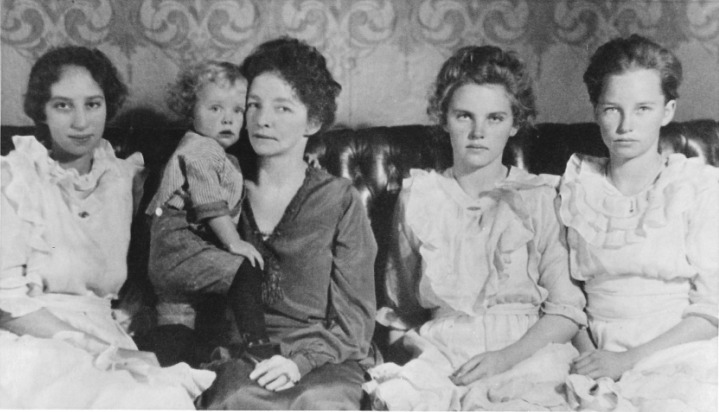
|
Subject: - Maude Reed, wife of O.K. Reed, and four of their children, about 1924. Left to right, Florence, little O.K., Maude, Helen and Lucille Reed.
|
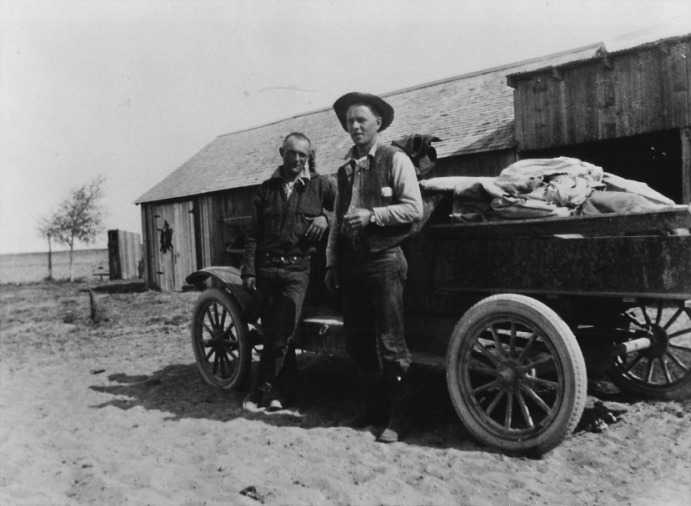
|
Subject: - Allen and Bob Mortell at the No. 1 well, United Cattle and Packing Company, in Stone Cabin Valley, early 1920s.
During World War I, the Mortell brothers designed and produced airplanes, assembling them at the Cedar Pipeline south of the
Kawich mountains; an attempt to sell the aircraft to the U.S. government failed.
|
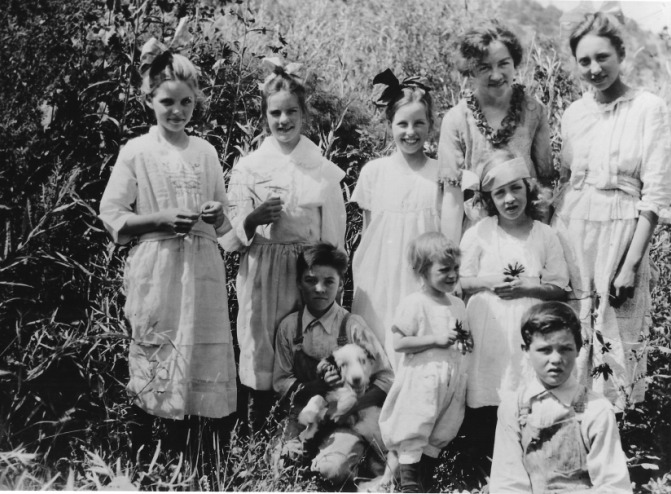
|
Subject: - Students at the school on O.K. Reed's ranch, Hawes Canyon, Kawich Mountains, Nye County, Nevada, early 1920s. Back
row, from left: Helen Reed, unidentified girl, Lucille Reed, teacher (name unknown), and Florence Reed. Front row: Jack May,
holding the dog; other children are unidentified, but may have belonged to the hired help who lived on the ranch.
|
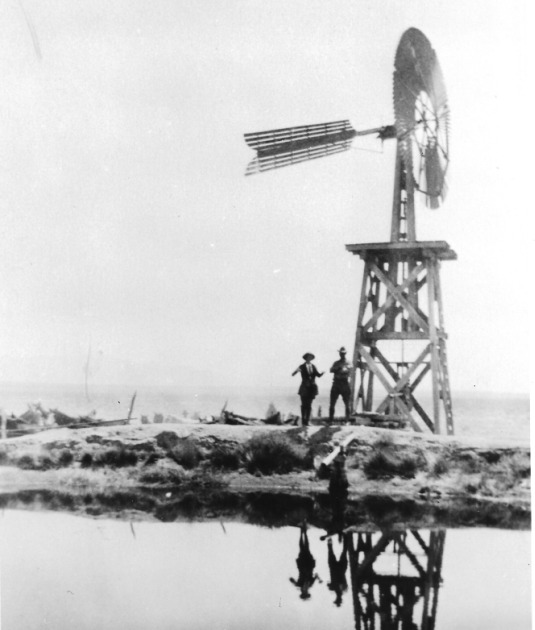
|
Subject: - No. 3 well of the United Cattle and Packing Company located in the Pine Creek area. Identity of persons pictured
is unknown. After installing a small windmill at this site and finding that it did not perform as expected, the company
furnishing the wells installed this experimental mill, which had large blades and provided more pumping power than the
smaller windmill.
|

|
Subject: - Johnny Reed and a woman of unknown identity. About 1922, Helen Reed was on her way out to the ranch and had just
passed the Indian camp at the mouth of Hawes Canyon. There she found an Indian baby who had been abandoned because he had
pneumonia and was dying. Helen Reed took the baby into her home, nursed him back to health, and raised him. They named him
Johnny. Johnny Reed was the grandson of Chief Kawich; when the Chief died, Johnny Reed became chief of the local Indians.
When Johnny Reed passed away, it was asked who was Johnny Reed's next of kin. At a powwow, it was decided that Helen Reed,
who had married a local resident, Ed Slavin, and lived in Tonopah, was the next of kin. thus, Helen was judged to be "Chief"
of the local Shoshone Indians.
|
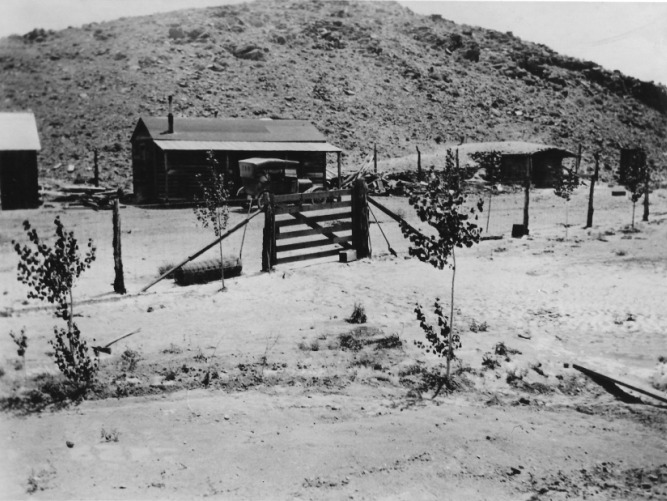
|
Subject: - Ed Reed's home at Cedar, at the end of Cedar Pipeline near the south end of the Kawich Mountains, Nye County, Nevada,
early 1920s. Ed Reed, brother of O. K. Reed and partner in the United Cattle and Packing Company, made his residence here;
he never married. This site is known for its very strong winds.
|

|
Subject: - Ed Reed's home at Cedar at the end of the Cedar Pipeline, Nye County, Nevada, early 1920s. the year this picture was taken, Ed
Reed tried to grow some corn, as seen in the foreground.
|

|
Subject: - Windmill at Cedar at the end of the Cedar Pipeline, south end of the Kawich Mountains, Nye County, Nevada, early 1920s.
|

|
Subject: - Children and workers at O.L. Reed's ranch, Hawes Canyon, Kawich Mountains, Nye County, Nevada, ca. 1920s. Frank May
is on the far left in the back row. George Bruno is the tall man in the dark hat in the middle of the back row. it may be O.K.
Reed on the far right in the back row. The three children kneeling in the front row belong to May and O.K. Reed.
|
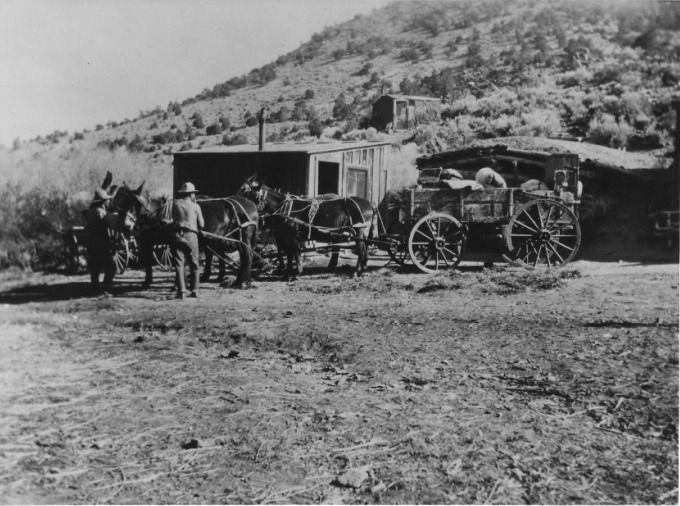
|
Subject: - O.K. Reed's ranch at Hawes Canyon, Kawich Mountains, Nye County, Nevada, prior to 1920. A four-mule team and wagon holding
supplies, including beds, grub, and necessary equipment, prepare to leave for the spring round-up.
|

|
Subject: - Working with a calf on the United Cattle and Packing company ranch, early 1920s. O.K. Reed is on the left, little O.K. is
at his father's feet, providing instruction, and one of the Fallini brothers, kneeling, is holding down the calf.
|
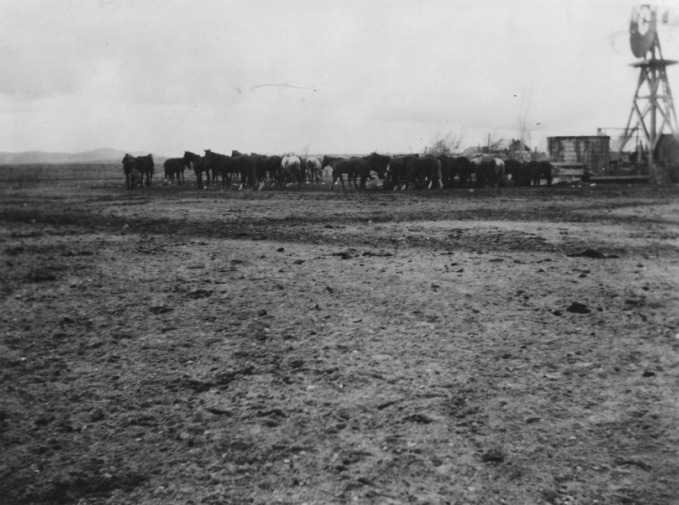
|
Subject: - Believed to be the No. 1 well, located in Stone Cabin Valley, probably early 1920s. The horses belong to the
United Cattle and Packing Company. When working cattle, riders received two horses each day, one for the morning and one for
the afternoon. Ed Slavin once protested jokingly, "Horses get tired, I get tired too."
|
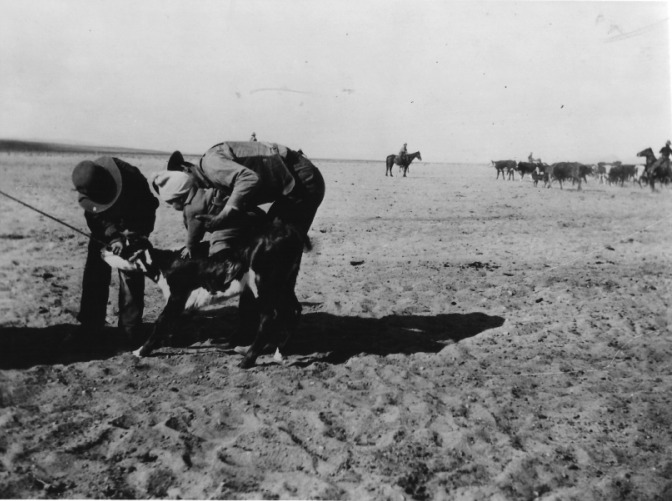
|
Subject: - O.K. Reed teaching little O.K. to ride a calf, about 1920.
|
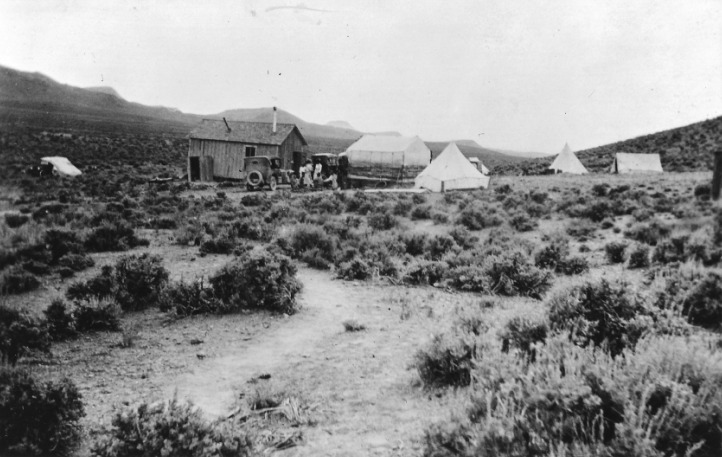
|
Subject: - Believed to be the cinnabar mine near Ned's Cache in Railroad Valley, Nevada, about 1920.
|
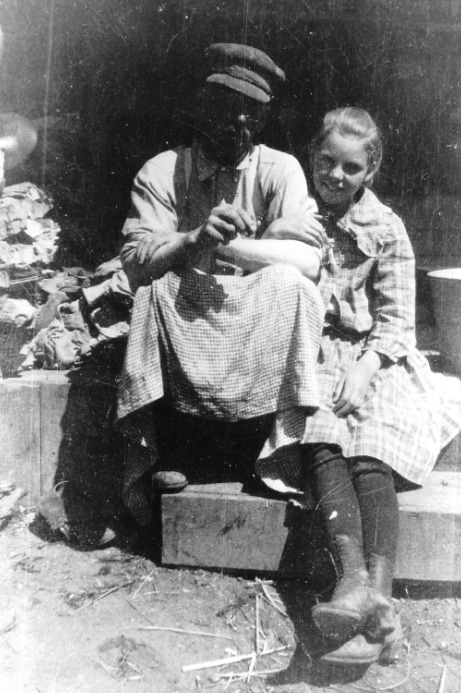
|
Subject: - O.K. Reed and his daughter Lucille, early 1920s, at Kawich or Gold Reed, Nevada.
|

|
Subject: - O.K. Reed's ranch at Hawes Canyon, Kawich Mountains, Nye County, Nevada, early 1920s. Hay fields are in the background.
|
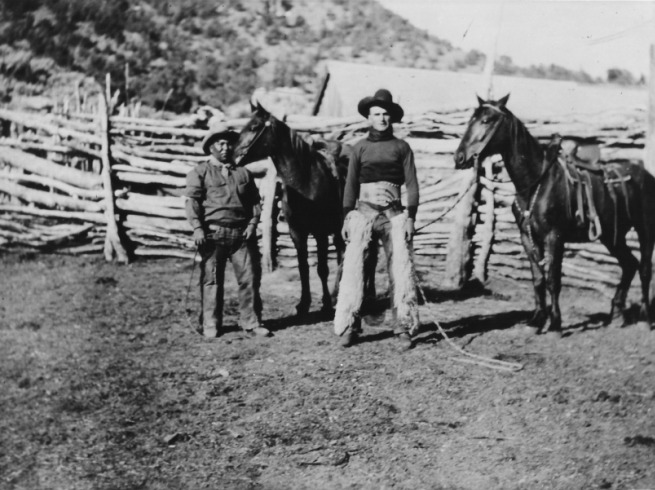
|
Subject: - O.K. Reed's ranch, Hawes Canyon, Kawich Mountains, Nye County, Nevada, early 1920s. An Indian named Cuny Clifford
is at the left. Clifford was adopted by the Clifford family, local ranchers, and raised much as Johnny Reed had been raised
by the Reeds. George Bruno stands on the right. Bruno was a cowboy and bronc buster who worked at the ranch. He made a try as
a cowboy actor in Hollywood; he once bet that he could ride a bucking horse with a 4-by4 board sitting under him for the
length of the ride. He won the bet. Bruno later married Maude Reed.
|
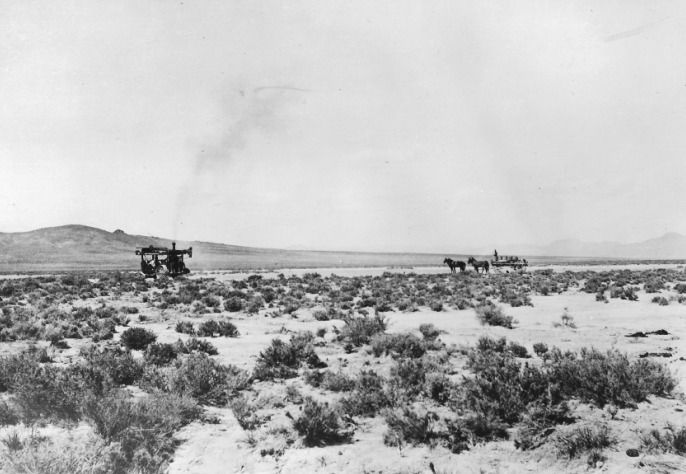
|
Subject: - O.K. Reed and his brother Ed acquired the Hawes Canyon Ranch from Andrew Jackson "Jack" Longstreet about 1908.
The Reed Ranch underwent rapid expansion until it encompassed an area more than 100 miles on a side in its east-west,
north-south dimensions. At its peak, it was one of the largest ranches ever in the United States. Although the Reeds and their
partners did not own all of the land, they had grazing rights and owned most of the water in an area perhaps encompassing more
than 3 million times. The Reeds drilled most of the wells themselves, sometimes digging a hundred feet by hand. Later they
acquired a steam-powered well drilling machine, pictured here in the early 1920s. A wagon and team of horses are hauling water
to the drill.
|
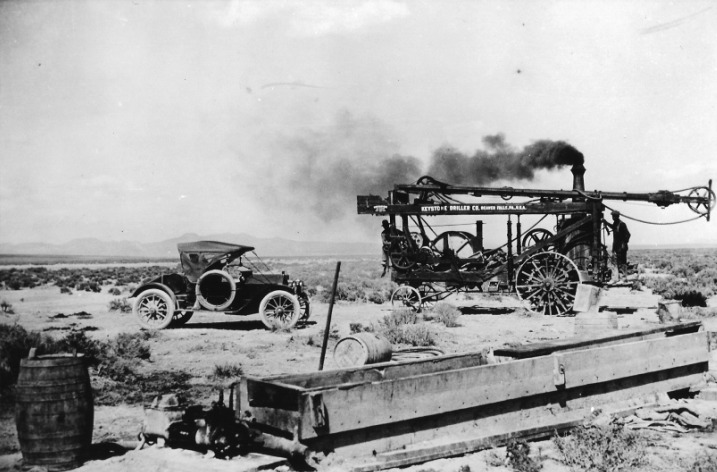
|
Subject: - A close-up of the steam-powered well-drilling machine owned by the United Cattle and Packing company. The drill
was manufactured by the Keystone Driller Company, Beaver Falls, Pennsylvania. Johnny Weaver operated the machine. The car has
been identified as a 1921 or 22 Ford or Dodge.
|

|
Subject: - Preparing for the spring round-up at the United Cattle and Packing Company, early 1920s. the older man in front
with the baby carriage is a joke: there was no baby in the carriage. it was symbolic of the fact that old men did not
participate in the round-up, but were instead told to stay home and take care of the ranch and the baby. This old man is Wake
Catlet, described by Ed Slavin as a "residue of the Civil War." Catlet was said to be the only man in Nye County of whom Jack
Longstreet was afraid.
|
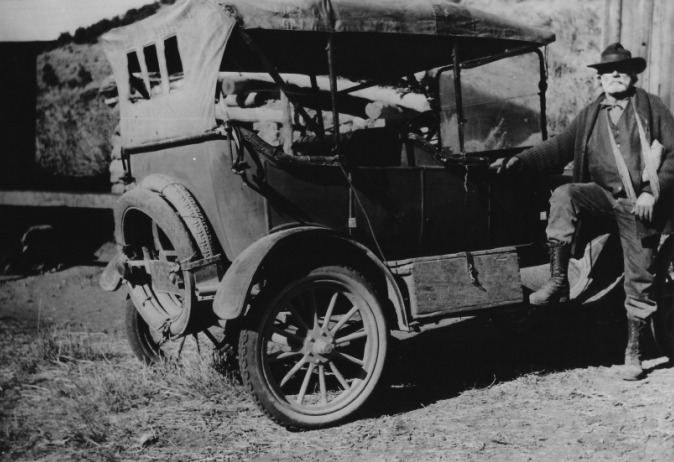
|
Subject: - Jack Longstreet with his Ford Model-T. it's said that Jack Longstreet had been shot in the arm and, refusing to
see a doctor, lived with an infected arm for many years. He did let Maude Reed attend to the arm, and also Maudes daughter
Helen Reed, when she got older. The arm, it's said, had a foul odor. When Longstreet made some money at his Longstreet Mine,
he finally went to Los Angeles and had the arm treated. This picture has been dated at about 1914 or 1916.
|
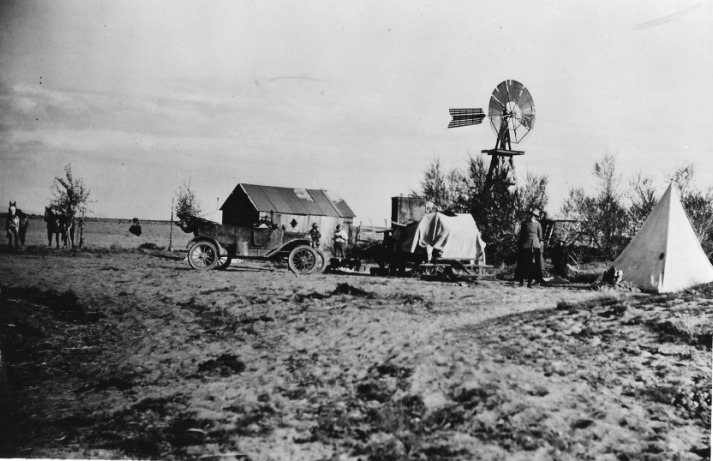
|
Subject: - The No. 1 well, located in Stone Cabin Valley, United Cattle and Packing Company, around 1920. The tent is the
style that the cowboys slept in on round-up. Both gas and wind were used to pump water. the gasoline-powered pump is inside
the shelter at the left. when demand for water was low the wind did the pumping, but when demand was high the gasoline-powered
pump was also used.
|
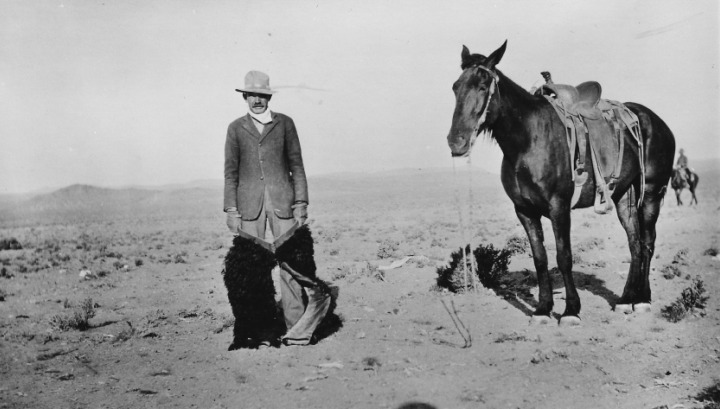
|
Subject: - O.K. Reed and his goatskin chaps, about 1920. Goat and sheep skins were used for chaps because of their warmth. Some riders had bearskin
chaps, of which they were very proud. Note the large size of Reed's horse.
|
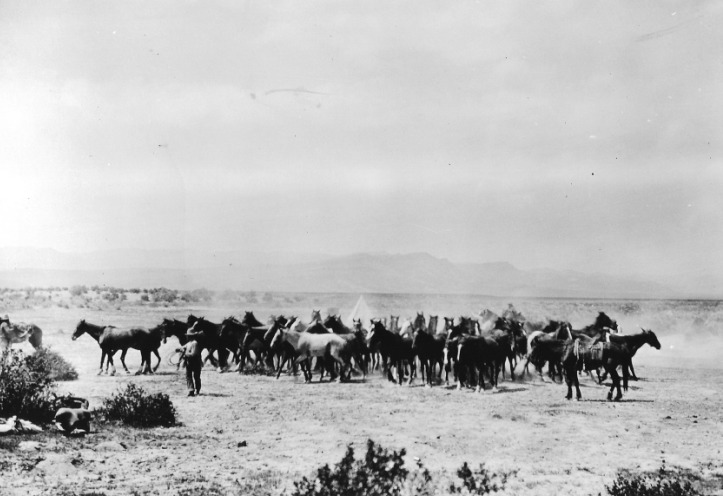
|
Subject: - Horses used during the round-up at the United Cattle and Packing company, about 1920.
|
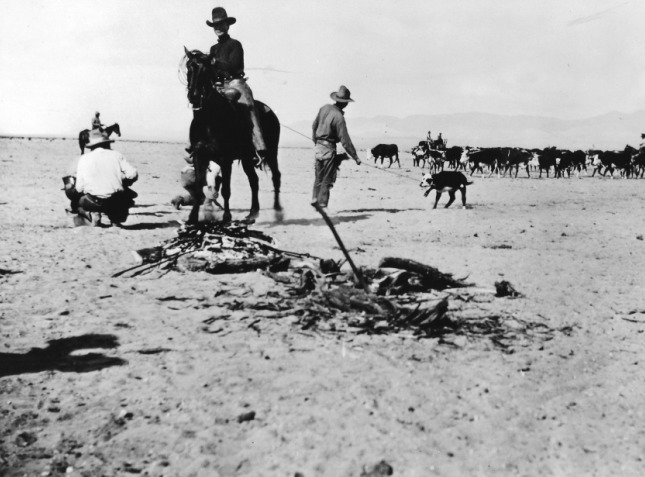
|
Subject: - Bringing a calf in on a rope at the United Cattle and Packing Company, probably early 1920s. George Bruno is riding the horse pulling the calf.
|
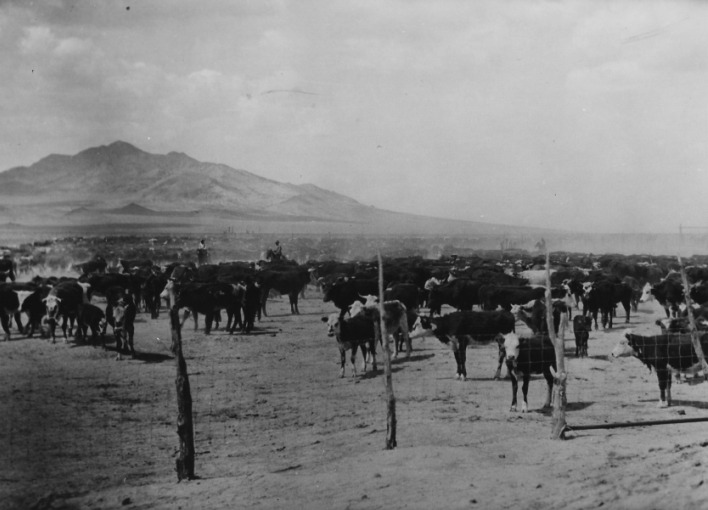
|
Subject: - Cattle contained inside a fence at the United Cattle and Packing company operations at Pine Creek or Cedar, Nye County, Nevada, early 1920s.
|
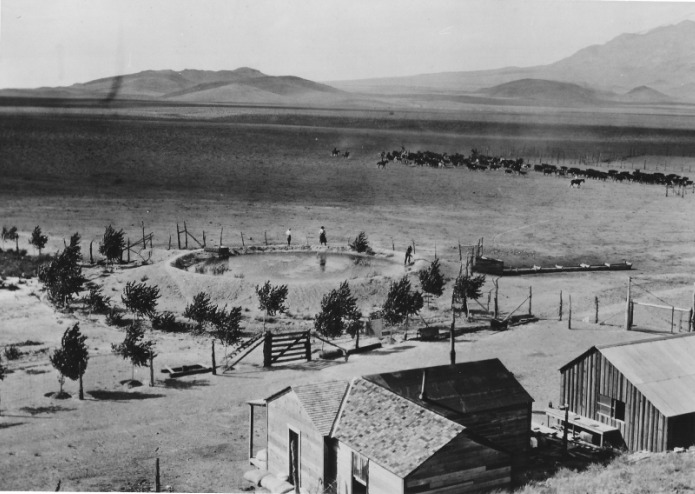
|
Subject: - Cedar, at the end of the Cedar Pipeline, south of the Kawich Mountains, Nye County, Nevada, about 1920. Picture
shows operations of the United Cattle and Packing Company, looking east toward Ned's Cache.
|
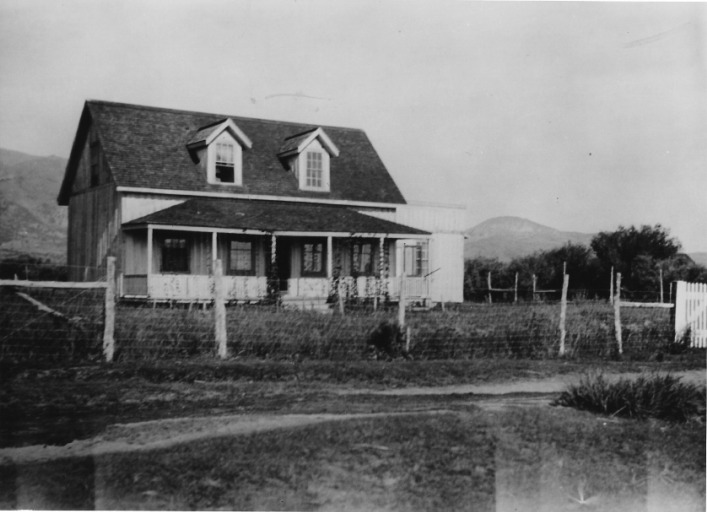
|
Subject: - The house at Pine Creek as it looked in the 1910s. The house burned down in the early 1920s.
|
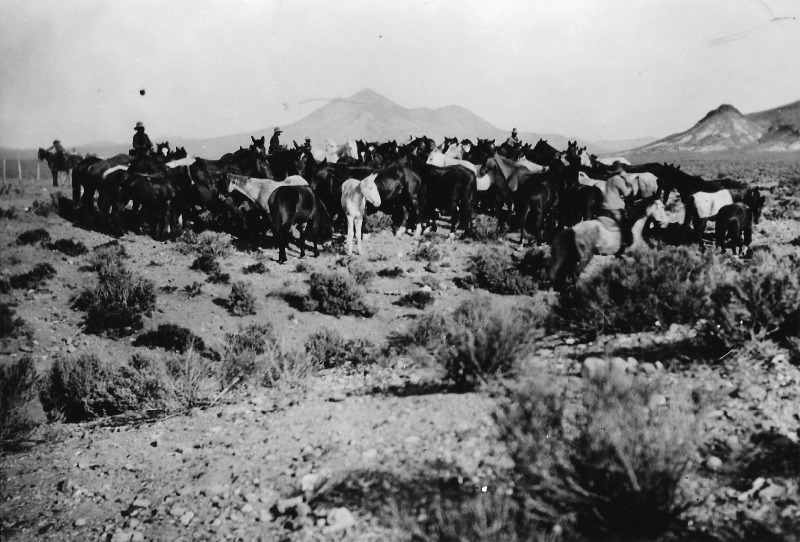
|
Subject: - Riders watching horses used in the round-up by the United Cattle and Packing Company, about 1920.
|
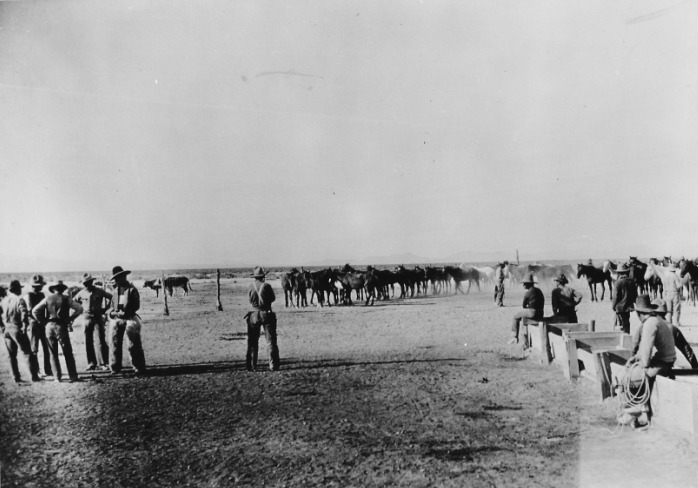
|
Subject: - Horses being gathered for the round-up, No. 1 well in Stone Cabin Valley, United Cattle and Packing Company, about 1920.
|

|
Subject: - Cattle belonging to the United Cattle and Packing Company in the 1920s. One year they had one herd with 4,000 head in it.
|
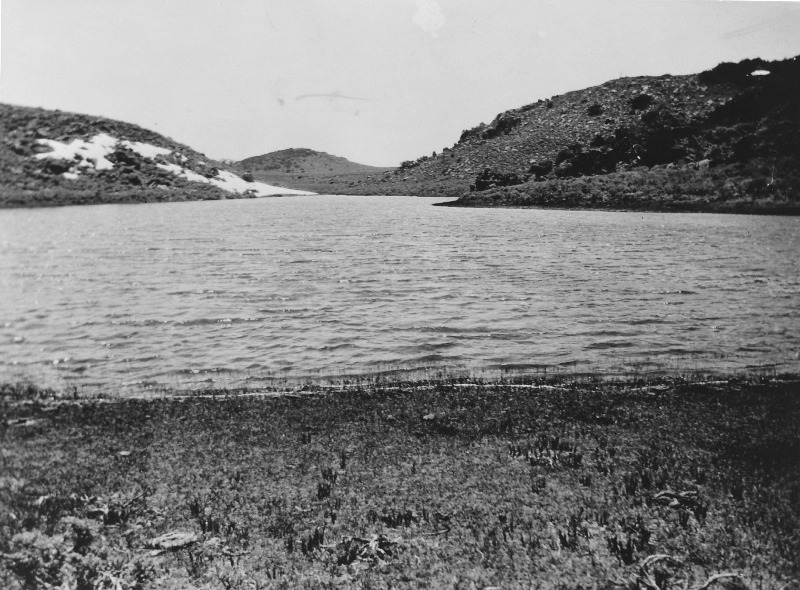
|
Subject: - This lake, 3 or 4 feet deep, a quarter of a mile wide, and 3/4ths of a mile long, stands on top of the Kawich Mountains, Nye County, Nevada, perhaps 1940s..
|
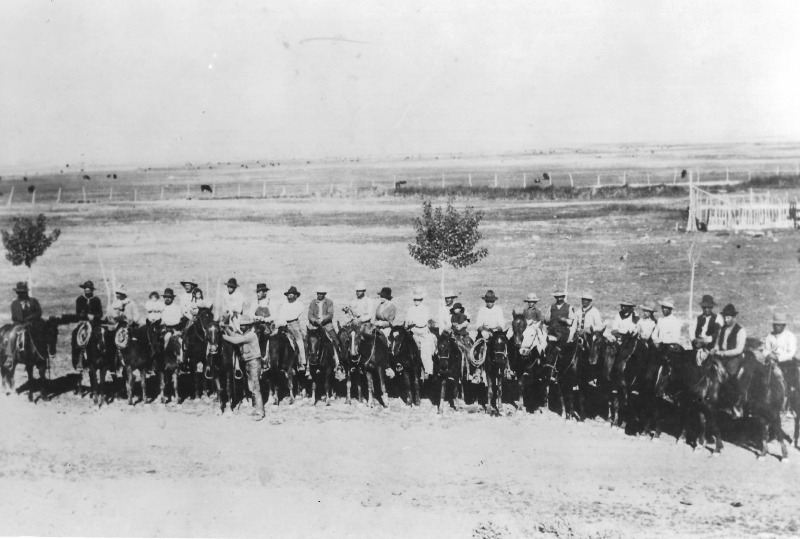
|
Subject: - Cattle round-up riders in the Kawich Mountains area, date unknown. The following names were supplied by Ed Slavin:
One Arm Bob (Indian), Charlie Gilbert, Lorigan Henry, Will Hatan, Charlie Williams (standing) Cully Turner, Joe Martin, Ed Reed,
Irving Allred, Ethel Allred, Mrs. Lydia Munson, Clarence Munson, George Hildebrand, William Fallini, Joe Cazeen, Fred Stevens,
Pigeon, E. Garrett, Tack Munson, Bill Heller, Booly Johnson and Jim Pony.
|

|
Subject: - Putting up hay at O.K. Reed's ranch in Hawes Canyon, Kawich Mountains, Nye County, Nevada, probably the 1930s or early 1940s.
|
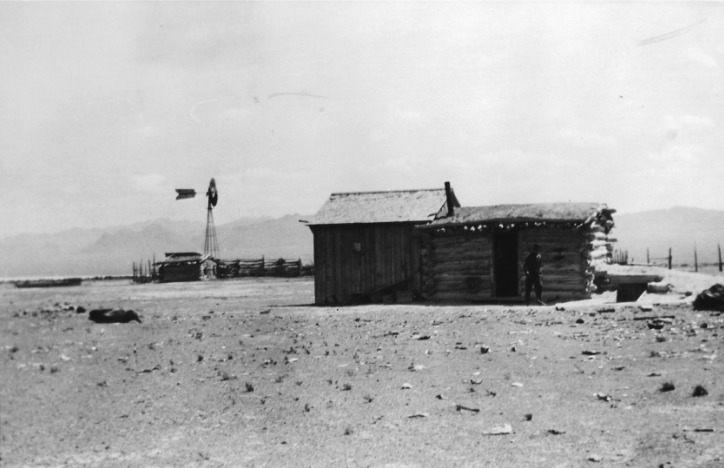
|
Subject: - Ed's Well, Railroad Valley, Nye County, Nevada, named after Ed Reed. The well is on property originally owned by
the 7-L Outfit, who sold it to the United Cattle and Packing Company. The Quinn Canyon Range is visible in the distance.
Probably the early 1920s.
|
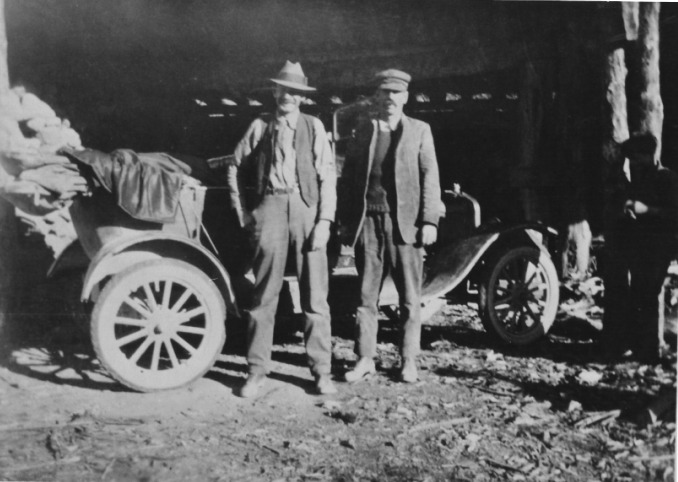
|
Subject: - Ed Reed, and O.K. Reed with what looks like a 1914 Model-T Ford. The Reed brothers were tall men; Ed was about 6'4" and O.K. was about 6',
described as big boned with no fat on their bodies. Ed had long legs, O.K. had short legs.
|
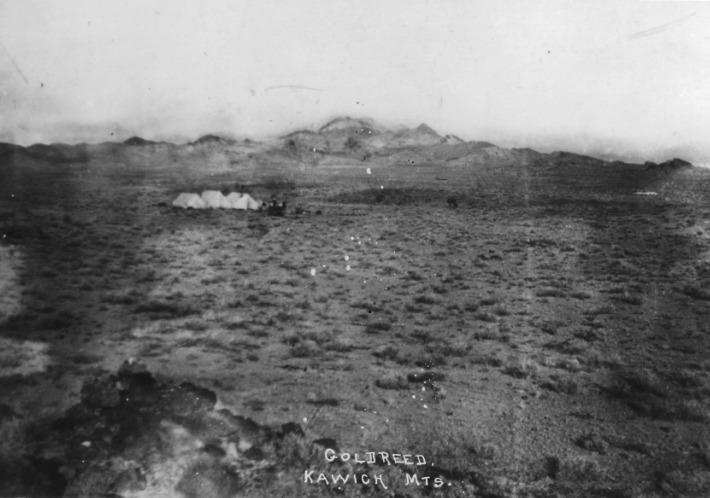
|
Subject: - Gold Reed, Kawich Mountains, Nye County, Nevada, probably about 1905. it was with a mine in Gold Reed that O.K.
Reed made the money to purchase the ranch at Hawes Canyon. The ore at the mine was so rich that person could stand off 50 or
60 feet and see the gold in the original outcropping; some of the ore sold for $1,000 a ton. Reed was partners in the mine
with Jack May and a Mr. Wardle, Tonopah resident Austin Wardle's father. Jack May and Reed were married to sisters, Mabel and
Maude Hanley.
|

|
Subject: - Four of the pretty girls who lived at O.K. Reed's ranch at Hawes Canyon, Kawich Mountains, Nye County, Nevada,
early 1920s. Left to right Lucille Reed, Catherine Way, Florence Reed and Helen Reed. the gloves the girls are wearing were
made by Indians living in the Hawes Canyon area.
|
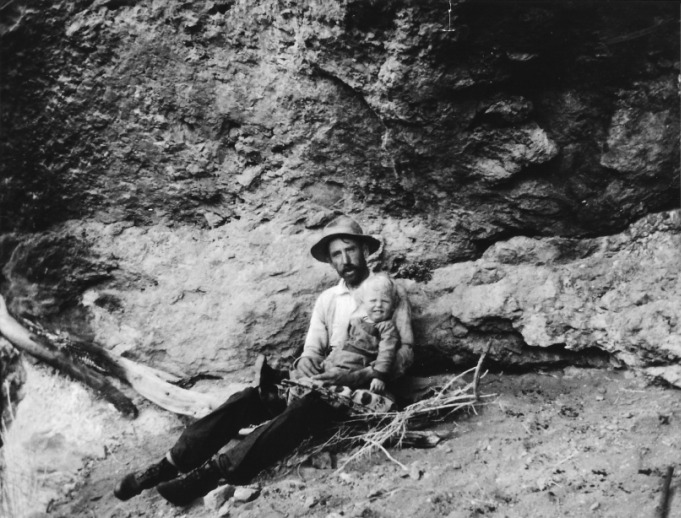
|
Subject: - O.K. Reed and his son, Little O.K., about 200 feet from where Reed and his partners had their mine at Gold Reed, about 1920.
|

|
Subject: - Tonopah's Championship Basketball Team, 1925. Back row standing from left, Coach Snyder, John Casselli, McGuire,
Jimmy Burns, Paul Richards, and Manager Bernard Fuetsch. Second Row, Bill Dumble, John Starr, and Ed Slavin. Sitting in front,
Chester Geyer and George Brown. While playing its last game in Ely that season the team received a telegram from home saying,
"Beat Ely and Chicago next." About $2,500 was raised in a few hours in Tonopah to send the team to participate in a tournament
in Chicago. The Tonopah lads, however, did not fare well in Chicago against older and bigger competition.
|

|
Subject: - A settlement sheet from the Tonopah Mining Company to Ed Slavin, dated November 20, 1941.
|
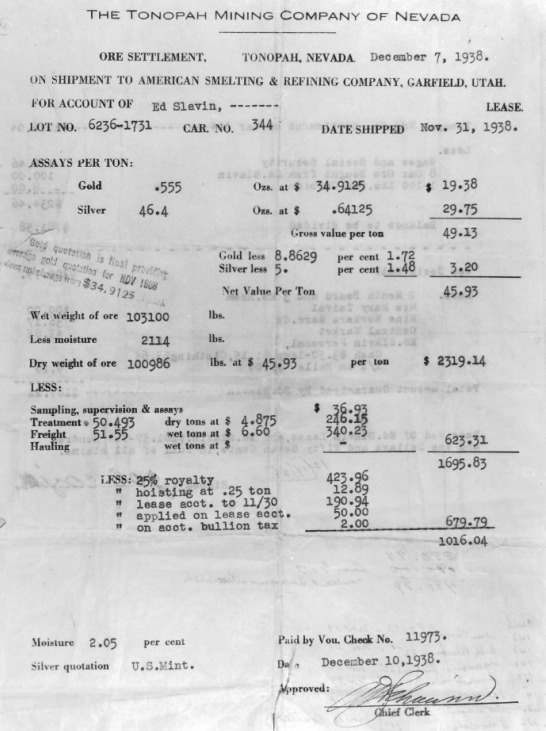
|
Subject: - A settlement sheet from the Tonopah Mining Company to Ed Slavin, dated December 7, 1938.
|

|
Subject: - The back side of the settlement sheet pictured above.
|

























































